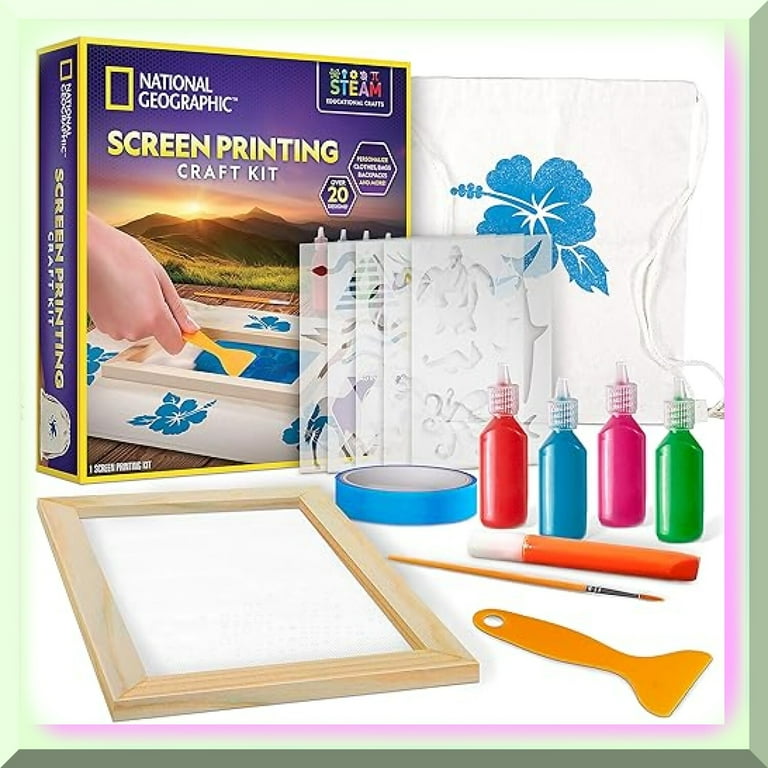Premium Screen Printing Kit for Business Startups
Premium Screen Printing Kit for Business Startups
Blog Article
Screen Printing Uncovered: Everything You Required to Understand About Tee Shirt and Garment Printing Strategies
If you have actually ever before questioned exactly how those lively styles wind up on your favorite t-shirts, you remain in the appropriate area. Screen printing is an interesting method that combines art with method, supplying countless opportunities for creative thinking. Comprehending the principles, from devices to ink options, can greatly affect your results. All set to check out the important aspects that make screen printing an art kind? Let's uncover the information that can raise your jobs.
The Essentials of Screen Printing: How It Functions
When you plunge right into screen printing, you'll find it's both a scientific research and an art. At its core, screen printing involves developing a stencil, or display, that enables ink to pass with only in details areas (screen printing kit). You begin by selecting your design and preparing your display with a light-sensitive emulsion. When you expose this solution to light, it hardens, leaving your layout as an unfavorable space.
Following, you'll mix your inks and prepare your printing surface area. Setting the screen over the textile, after that utilize a squeegee to push ink through the screen onto the garment. This procedure calls for precision, as you want clear, dynamic prints. After printing, you'll heal the ink with heat, ensuring it adheres to the material and lasts via washes. Each step is essential, and understanding them will elevate your screen printing abilities, transforming easy garments into special, expressive items.
Sorts Of Display Printing Techniques
Once you grasp the basics of screen printing, it's time to explore the various strategies that can raise your layouts. One prominent technique is standard screen printing, where ink is pushed through a stenciled display. This strategy is excellent for vibrant, vivid shades. There's water-based ink printing, which supplies a softer feeling and is environment-friendly, however it requires a various technique to treating.
One more alternative is plastisol printing, recognized for its resilience and dazzling shades, making it a favorite for many brand names. Experiment with halftone printing to create gradient impacts and elaborate layouts.
Necessary Tools for Display Printing
To attain magnificent outcomes in screen printing, having the appropriate equipment is basic. You'll need a sturdy display printing framework, which holds the mesh that transfers your style onto the garment. Next, invest in top notch mops; these are necessary for using ink equally throughout the screen.
Picking the Right Inks and Products
When choosing inks and products for screen printing, you need to consider the kind of ink that functions best for your task. Consider material compatibility to guarantee your designs look excellent and last lengthy. Additionally, explore green ink alternatives to make your printing procedure a lot more lasting.
Types of Screen Inks
Picking the right display ink is vital for accomplishing vibrant, resilient prints that meet your project's demands. There are a number of kinds of screen inks to analyze. Specialty inks, such as glow-in-the-dark or metallic, can include one-of-a-kind impacts to your layouts.

Fabric Compatibility Considerations
Recognizing textile compatibility is vital for attaining high-quality display prints, specifically considering that different products respond uniquely to numerous inks. Always examine your inks on sample material to assure they adhere appropriately and maintain color stability. Additionally, keep in mind that textile weight and texture can influence the final result, so picking the appropriate ink and product combination is important for your task's success.
Eco-Friendly Ink Options
Eco-friendly inks are coming to be a prominent option for display printers who intend to reduce their environmental effect while keeping quality. When picking inks, consider water-based inks, which are less dangerous and easier to cleanse up contrasted to traditional solvents. These inks bond well with materials, providing vivid results without toxic chemicals. You might likewise discover eco-solvent inks that make use of fewer unpredictable natural compounds (VOCs), making them a much safer choice for both your health and wellness and the earth.
Furthermore, look for inks made from renewable resources, such as soy or vegetable-based options. By picking the ideal inks and products, you'll not only create sensational designs but likewise contribute to a much more lasting printing procedure. Make the switch, and your prints will show your dedication to the atmosphere!
Preparing Your Style for Display Printing

File Style Demands
To ensure your style looks sharp and vivid on fabric, you'll need to pay attention to file style demands for screen printing. Start with vector documents like AI or EPS, as they can be scaled without losing high quality. If you use raster images, go with high-resolution documents, such as TIFF or PNG, ideally at 300 DPI. Stay clear of making use of JPEGs, as they can shed quality when resized. Additionally, make certain your style has a transparent background to avoid undesirable white edges on your prints. Finally, keep shade modes in mind; CMYK is basic for screen printing, so convert your RGB designs accordingly. By adhering to these standards, you'll set your art work up for a successful print.
Shade Separation Techniques
Color splitting up is a necessary action in preparing your style for display printing, and grasping it can significantly boost your print quality. You'll require to damage your design into specific shades, as each color requires a separate screen throughout printing. Start by recognizing all the colors in your design and produce layers each. You can use software program like Adobe Photoshop or Illustrator to separate and separate colors successfully. Be certain to save each layer as a separate documents, usually in a format like TIFF or PSD. This precision not only ensures precise color depiction however additionally streamlines the printing procedure. By focusing on color separation, you'll achieve specialist and vivid lead to your screen-printed garments.
Resolution and Size
Accomplishing the best lead to screen printing begins with ensuring your style has the best resolution and size. Preferably, your art work should be at the very least 300 DPI (dots per inch) for sharp, clear prints. If you make use of reduced resolution, your last item may look amateur and pixelated.
When it pertains to dimension, consider the measurements of your print location. Layout your art work to match the final print dimension, ideally developing it in the actual dimensions you'll be publishing. This way, you'll stay clear of any type of unforeseen scaling problems.
Constantly inspect your layout in both vector and raster formats. Vector graphics can be scaled without shedding high quality, making them excellent for screen printing. Preparing appropriately will guarantee your layout looks remarkable on every garment!
Step-by-Step Display Printing Process
Display printing is a vibrant process that enables you to develop lively layouts on different surface areas. To begin, you'll need a display, emulsion, and your picked ink. First, prepare your display by cleansing it extensively. Next off, apply the solution evenly and let it completely dry in a dark location. When completely dry, expose your screen to light with your style positioned on it, which will solidify the solution where the light hits, creating a stencil - screen printing kit.
Put ink onto the display and use a squeegee to push the ink with the pattern onto the textile. Lift the screen very carefully and let the print completely dry. You've effectively display printed your layout.
Tips for Effective Screen Printing Projects
While you're diving right into your display printing projects, bear in mind that prep work is essential to success. Beginning by gathering all your materials-- inks, garments, displays, and mops. A clean office helps protect against undesirable errors, so clean prior to you begin.
Next, validate your artwork is high-resolution and correctly sized for your garment. Check your display for appropriate exposure and tidy it thoroughly to stay clear of smudges. When blending your inks, comply with the supplier's guidelines to attain the ideal consistency.
Throughout printing, use also stress with your squeegee for constant results. Don't hurry; take your time to verify each print fulfills your standards. After printing, let your garments dry completely before managing or packaging them.
Finally, always keep a sample of your help future reference. In this manner, you can evaluate your development and enhance your strategies in time. Pleased printing!

Often Asked Concerns
How Lengthy Does It Take to Set up a Display Printing Job?
Setting up a display printing task generally takes around half an hour to an hour. You'll prepare the displays, mix inks, and readjust the press. The moment varies based upon complexity and experience, so stay arranged!
Can I Publish on Different Fabric Types Utilizing the Same Method?
Yes, you can publish on different fabric types using the exact same technique, yet you'll require to adjust your settings and inks. Some fabrics absorb ink differently, so experimenting warranties the best outcomes for every product.
What Are Usual Mistakes to Stay Clear Of in Display Printing?
When display printing, avoid usual errors like utilizing the wrong ink, neglecting appropriate exposure times, or missing pre-press checks. Constantly test your arrangement and keep clean displays to assure top quality screen printing kit outcomes each time.
How Can I Appropriately Tidy and Maintain My Screen Printing Tools?
To effectively clean and maintain your display printing tools, you need to on a regular basis clean screens with suitable solvents, check squeegees for wear, and guarantee all devices are saved completely dry and dust-free. Uniformity avoids expensive repair services and boosts performance.
Is Screen Printing Environmentally Pleasant Compared to Other Methods?
Screen printing can be more eco-friendly than other approaches, specifically if you utilize water-based inks and eco-conscious materials. By choosing sustainable supplies and practices, you minimize waste and decrease your impact on the world.
Display Printing Uncovered: Everything You Need to Know Concerning Tee Shirt and Garment Printing Methods
At its core, screen printing includes creating a stencil, or display, that permits ink to pass through just in particular locations. Placement the screen over the fabric, then utilize a squeegee to push ink through the screen onto the garment. One popular approach is typical display printing, where ink is pushed via a stenciled display.When selecting inks and products for display printing, you require to take right into account the type of ink that functions finest for your job.
Report this page